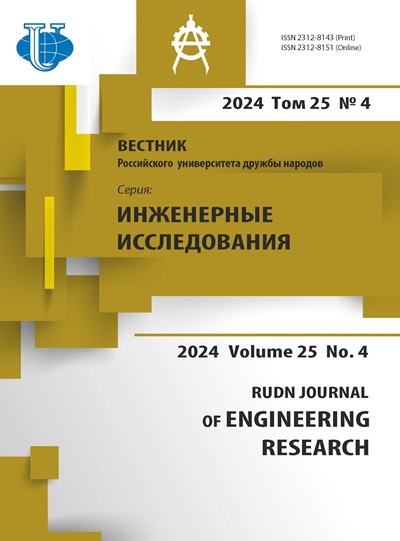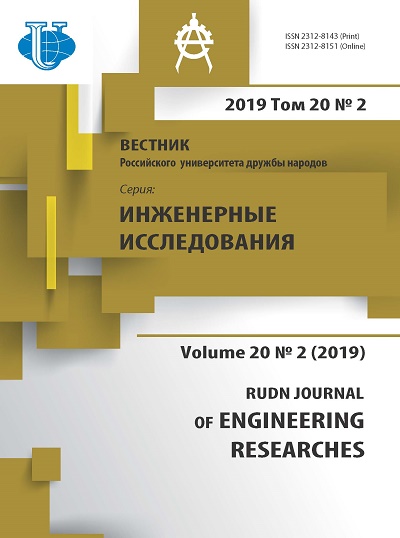Experience and opportunities of space systems applications of Earth remote sensing to prediction gold mineralization on difficult to approach areas on the example of the Polar Urals
- Authors: Ivanova J.N.1,2, Ivanov K.S.3, Bondareva M.K.3, Ermolaev V.A.3, Zhukov A.O.4
-
Affiliations:
- Institute of Geology of Ore Deposits, Petrography, Mineralogy and Geochemistry of Russian Academy of Sciences
- Peoples’ Friendship University of Russia (RUDN University)
- Titov Main Test and Space Systems Control Centre
- Lomonosov Moscow State University
- Issue: Vol 20, No 2 (2019)
- Pages: 123-133
- Section: Aviation and rocket and space technology
- URL: https://journals.rudn.ru/engineering-researches/article/view/22670
- DOI: https://doi.org/10.22363/2312-8143-2019-20-2-123-133
Cite item
Full Text
Abstract
The questions of the using of domestic and foreign spacecraft (SC), as well as Earth remote sensing (ERS) equipment for search and predication of gold mineralization on the example of the promising and difficult to approach areas of the Polar and the Northern Urals are discussed in the article. The solution of this problem is showed on the example of the prospective areas of the Arctic and the Northern Urals based on analysis of Landsat 7 multispectral images. Hidden structures (arc, annular, and radial) were detected with help of analyses of Landsat 7 imagery. Hidden structures determine the position of gold mineralization of the Toupugol-Hanmeyshorskogo (the Novogodnenskoe ore field, the Polar Urals) and the Turinsko-Auerbahovskogo (the Auerbachovskoe ore field, the Northern Urals) ore regions. The decision of this problem is given on the example of the promising territory of the Polar Urals with the use foreign SC the Landsat 7. Comparative analysis of the existing SC of ERS has been carried out, this target information has in the public domain. The onboard equipment installed on domestic spacecraft and the information obtained with use onboard equipment meets the existing requirements. These requirements are placed to onboard equipment to solve the problem of search and predication mineralization. At the same time, the capabilities of the deployed domestic orbital grouping of SC of ERS transcend the capabilities of SC of ERS the Landsat 7. Opportunity of obtaining geospatial information with the use of pseudospacecrafts is being considered. These have several advantages over SC and unmanned aerial vehicles.
About the authors
Julia N. Ivanova
Institute of Geology of Ore Deposits, Petrography, Mineralogy and Geochemistry of Russian Academy of Sciences; Peoples’ Friendship University of Russia (RUDN University)
Author for correspondence.
Email: jnivanova@yandex.ru
researcher in Laboratory of Geology of Ore Deposits of IGEM RAS; Associate Professor of the Department of Geology, Mining and Oil and Gas Industry of Academy of Engineering, PhD
35 Staromonetny Lane, Moscow, 119017, Russian Federation; 6 Miklukho-Maklaya St., Moscow, 117198, Russian FederationKirill S. Ivanov
Titov Main Test and Space Systems Control Centre
Email: jnivanova@yandex.ru
head of the 101 Scientific Testing Laboratory, Deputy Head of the 10 Scientific Testing Department, PhD
3 Oktyabrskaya St., Krasnoznamensk, 141090, Russian FederationMarina K. Bondareva
Titov Main Test and Space Systems Control Centre
Email: jnivanova@yandex.ru
leading researcher of the 11th Scientific Testing Department, Doctor of Sciences, Associate Professor
3 Oktyabrskaya St., Krasnoznamensk, 141090, Russian FederationVladimir A. Ermolaev
Titov Main Test and Space Systems Control Centre
Email: jnivanova@yandex.ru
senior researcher, 101 Research Laboratory
3 Oktyabrskaya St., Krasnoznamensk, 141090, Russian FederationAlexander O. Zhukov
Lomonosov Moscow State University
Email: jnivanova@yandex.ru
leading researcher of Sternberg Astronomical Institute, Doctor of Sciences, Associate Professor
13 Universitetsky Ave., Moscow, 119234, Russian FederationReferences
- Kirensky AS, Korchagin VP, Kuzmenko RG. Opyt tektonicheskogo rayonirovaniya s ispol'zovaniyem kosmicheskikh snimkov [Experience of tectonic zoning with the use of satellite imagery]. Metody distantsionnykh issledovaniy dlya resheniya prirodovedcheskikh zadach. 1986: 54–62. (In Russ.)
- Graham GE, Kokaly RF, Kelley KD, et al. Application of imaging spectroscopy for mineral exploration in Alaska: a study over porphyry Cu deposits in the Eastern Alaska Range. Economic Geology. 2018;11(2): 489–510.
- Menshikov VA, Perminov AN, Rembeza AI, et al. Osnovy analiza i proyektirovaniya kosmicheskikh sistem monitoringa i prognozirovaniya prirodnykh i tekhnogennykh katastrof [Base of analysis and design of space systems for monitoring and predication natural and manmade disasters]. Moscow: Mashinostroenie Publ.; 2014. (In Russ.)
- Nezampour MH, Rassa I. Using remote sensing technology for the determination of mineralization in the Kal-e-Kafi porphyritic deposit, Anarak, Iran. Mineral Deposit Research: Meeting the Global Challenge. 2005: 565–567. Available from: doi.org/10.1007/3-540-27946-6_145
- Zverev AT, Malinnikov VA, Arellano-Baeza A. Prognoz mestorozhdeniy rudnykh poleznykh iskopayemykh na territorii Chili na osnove lineamentnogo analiza kosmicheskikh izobrazheniy [Forecast of mineral deposits in Chile based on lineament analysis of satellite images]. Izvestiya vishchikh uchebnykh zavedeniy. Geodeziya i aerofotosyemka [Proceedings of the Higher Educational Institutions. Geodesy and aerophotosurveying]. 2005; 6: 62–69. (In Russ.)
- Tommaso ID, Rubinstein N. Hydrothermal alteration mapping using ASTER data in the Infiernillo porphyry deposit, Argentina. Ore Geology Reviews. 2007;32(1–2): 275–290.
- Zhang X, Pazner M, Duke N. Lithologic and mineral information extraction for gold exploration using ASTER data in the south Chocolate Mountains (California). Journal of Photogrammetry and Remote Sensing. 2007;62(4): 271–282.
- Milovsky GA, Rudakov VV, Lebedev VV, Korenyuk MK, Shaibakova LA, Filippov DV. Primeneniye kosmicheskoy s"yemki dlya prognoza zolotogo orudeneniya v zonakh glubinnykh razlomov na Severo-Vostoke Rossii [Application of space borne survey for forecasting of gold mineralization in deep fault zones in the NorthEast of Russia]. Earth observation and remote sensing. 2010;3: 30–34. (In Russ.)
- Zverev AT, Gavrilova VV. Razrabotka teorii i metodov otsenki i prognoza sostoyaniya prirodnykh resursov s ispol'zovaniyem kosmicheskikh snimkov [Development of the theory and methods for assessing and prediction of natural resources state with use of satellite imagery]. Izvestiya vishchikh uchebnykh zavedeniy. Geodeziya i aerofotosyemka [Proceedings of the Higher Educational Institutions. Geodesy and aerophotosurveying]. 2012;5: 44–47. (In Russ.)
- Vural A, Corumluoglu Ö, Asri I. Remote sensing technique for capturing and exploration of mineral deposit sites in Gumushane metallogenic province, NE Turkey. Journal Geology Society of India. 2017;90(5): 628–633. Available from: doi.org/10.1007/s12594-017-0762-0
- Yousefi T, Aliyari F, Abedini A, Asghar Calagari A. Integrating geologic and Landsat-8 and ASTER remote sensing data for gold exploration: a case study from Zarshuran Carlin-type gold deposit, NW Iran. Arabian Journal of Geosciences. 2018;11: 1–19.
- Ivanova JN, Vyhristenko RI, Vikentyev IV. Geologicheskaya pozitsiya i strukturnyy kontrol' orudeneniya Toupugol-Khanmeyshorskogo rayona (Polyarnyy Ural) po rezul'tatam distantsionnogo zondirovaniya [Geological position and structural control of ore mineralization of the Toupugol-Khanmeyshorsky district (the Polar Urals) as a result of remote sensing]. Earth Observation and Remote Sensing. 2019. (In press.) (In Russ.)
- Yazeva RG, Bochkarev VV. Voykarskiy vulkanoplutonicheskiy poyas (Polyarnyy Ural) [Voikarsky volcanoplutonic belt (the Polar Urals)]. Sverdlovsk: USC of USSR Academy of Sciences; 1984. (In Russ.)
- Vikentiev IV, Murzin VV, Tyukova EE, et al. Vorontsovskoye zolotorudnoye mestorozhdeniye. Geologiya, formy zolota, genezis [Vorontsovskoe gold deposit. Geology, forms of gold, genesis]. Ekaterinburg: Fort Dialog-Iset Publ.; 2016. (In Russ.)
- Vikentyev IV, Ivanova YN, Tyukova EE, et al. Zoloto-porfirovoye Petropavlovskoye mestorozhdeniye (Polyarnyy Ural): geologicheskaya pozitsiya, mineralogiya i usloviya obrazovaniya [Porphyry-Style Petropavlovskoe Gold Deposit, the Polar Urals: Geological Position, Mineralogy, and Formation Conditions]. Geology of Ore Deposits. 2017;59(6): 482–520. (In Russ.)
- Vyhristenko RI. Paleovulkanicheskiye postroyki Tur'insko-Auerbakhovskogo i Valentorskogo rudnykh rayonov i svyazannyye s nimi mestorozhdeniya zolota i medi [Paleovolcanic structures of the Turiyinsko-Auerbakhovsky and the Valentorsky ore districts and the gold and copper deposits connected with them]. Bulletin of Peoples' Friendship University of Russia. Series: Engineering researches. 2014;4: 122–128. (In Russ.)
- Verba VS. (ed.) Radiolokatsionnyye sistemy zemleobzora kosmicheskogo bazirovaniya [Radiolocation system of ground view of space-based ground]. Moscow: Radiotekhnika Publ.; 2010. (In Russ.)
- The scientific center for operational Earth monitoring. Available from: http://www.ntsomz.ru/ks_dzz/satellites
- Characteristic of the shooting devices. Available from: https://eos.com
- Yemelyanova JG, Khachumov VM, Vatutin VM, et al. Analiz baz dannykh resheniya zadach monitoringa Arkticheskoy zony [Analysis of databases for solving problems of monitoring the Arctic zone]. Aktual'nyye problemy raketno-kosmicheskogo priborostroyeniya i informatsionnykh tekhnologiy: Sbornik trudov VIII Vserossiyskoy nauchno-tekhnicheskoy konferentsii, 1–3 iyunya 2016 [Actual problems of rocket and space instrument engineering and information technologies: Collection of works of the VIII All-Russian Scientific and Technical Conference, June 1–3, 2016]. Moscow: AO “RKS”; 2016. (In Russ.)
- Klimenko NN. Psevdokosmicheskiye apparaty dlya dlitel'nogo nepreryvnogo nablyudeniya lokal'nykh rayonov [Pseudo-spacecrafts for long-term continuous observation of local areas]. Vestnik NPO imeni S.A. Lavochkina. 2017;4(38): 122–134. (In Russ.)
















